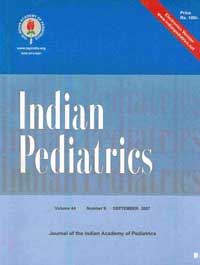|
|
|
Indian Pediatr 2008;45: 1008-1009 |
 |
Disseminated Cysticercosis in an Infant |
|
Bhavna Dhingra,
Devendra Mishra,
Department of Pediatrics,
Chacha Nehru Bal Chikitsalaya,
Geeta Colony, New Delhi 110 031, India.
E-mail: [email protected]
|
|
Neurocysticercosis is quite common in India(1) but by
virtue of its prolonged incubation period (average 7 years) and the
nutritional habits of infants, it is rarely seen in this age-group(2,3).
A previously healthy twelve month-old male child
presented to us with a history of three episodes of sudden onset,
right-sided tonic-clonic seizures followed by unconsciousness for about
ten minutes after each episode, over last five days. There was no
associated fever, head trauma, tubercular contact or family history of
seizures. The family belonged to the lower socioeconomic group and resided
in an urban slum and grew vegetables in a small patch of land. Parents
were non vegetarian, but did not consume pork. The child’s present diet
included top milk, soft gruel and/or some items from the family pot, and
breastfeeding. Sanitary toilet facility and safe water were not available
to the family. There was no history of worm infestation in the child or
the family. On admission, a soft to firm, well-defined, non-tender and
non-fluctuant subcutaneous swelling about 2×3 cm in size was noticed in
the lumbosacral region. Examination and routine investigations were
normal. FNAC of the sacral swelling revealed cysticercus cellulosae.
A CECT scan of head revealed a single inflammatory granuloma suggestive of
neuro-cysticercosis. The child was treated with anti-epileptics and
cysticidals in view of disseminated cysticercosis. The child has been
seizure free for the last 10 months. The subcutaneous swelling has also
regressed in size.
Only two authors(4,5) have reported neurocysticercosis
in infants and none has reported disseminated disease. An early
presentation of disseminated disease in this case suggests that the long
incubation period reported is not absolute and other factors like the
innate immunity of the individual do have a role in modifying the
presentation. Food habits and faecal disposal practices play a major role
in the spread of the disease in India(1). Hygienic food handling practices
and hand washing must be emphasized for prevention of neurocysticercosis.
References
1. Rajshekhar V, Joshi DD, Doanh NQ, Van De N, Xiaonong
Z. Taenia solium taeniosis/ cysticercosis in Asia: epidemiology, impact
and issues. Acta Trop 2003; 87: 53-60.
2. Vasconcelos MM, Ramos MR, Schwan PJ, Domingues R,
Alencar KC, Herdy GH. Neurocysticercosis in a preschool age child. Arq
Neuropsiquatr 2000; 58: 909-912.
3. Stamos JK, Rowley AH, Hahn YS, Chadwick EG,
Schantz PM, Wilson M. Neurocysticercosis: report of unusual pediatric
cases. Pediatrics 1996; 98: 974-977.
4. Basu S, Ramchandran U, Thapliyal A. Clinical profile
and outcome of pediatric neurocysti-cercosis: A study from Western Nepal.
J Pediatr Neurol 2007; 5: 45-52.
5. Scott JX, Devi A, Kumar TS, Moses PD. A rare presentation of
neurocysticercosis in a young child. J Trop Pediatr 2005; 51: 254-255. |
|
|
 |
|

